Pope Francis is a Public Health Advocate

“The world today is mostly deaf,” the Pontiff observes in Pope Francis: A Man of His Word, Wim Wenders’ documentary on this religious leader who likes to quote Dostoevsky, joke about mothers-in-law, and advocate for the sick, the poor, the disenfranchised, and Planet Earth. He is, I realized while watching this film and hearing this man of words, a public health advocate. Throughout the film, we see clips of Pope Francis washing the feet of prisoners in Philadelphia, comforting dying children in a pediatric clinic in central Africa, and speaking out to the U.S. Congress about the dangers of climate
The US Covered Nearly 50% of Global Oncology Medicine Spending in 2017 – a market update from IQVIA
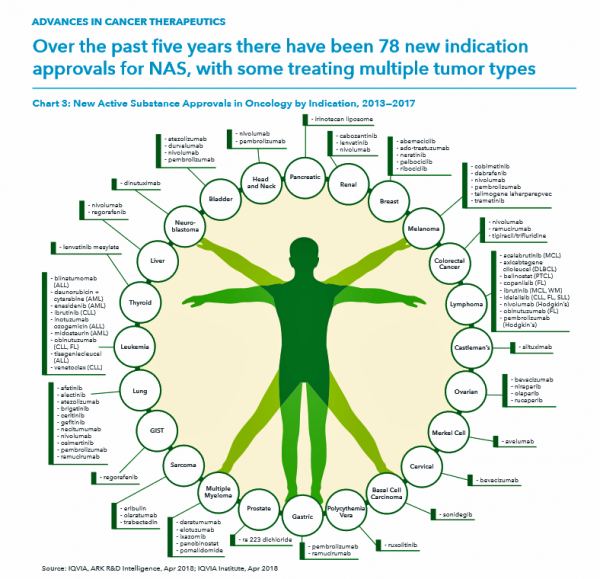
“We are at a remarkable point of cancer treatment,” noted Murray Aitken, Executive Director, IQVIA Institute for Human Data Science, in a call with media this week. 2017 was a banner year of innovative drug launches in oncology, Aitken coined, with more drugs used more extensively, driving improved patient for people dealing with cancer. This upbeat market description comes out of a report on Global Oncology Trends 2018 from the IQVIA Institute for Human Data Science. The subtitle of the report, “Innovation, Expansion and Disruption,” is appropriately put. The report covers these three themes across four sections: advances in therapies,
Universal Health Care and Financial Inclusion – Two Sides of the Wellness Coin
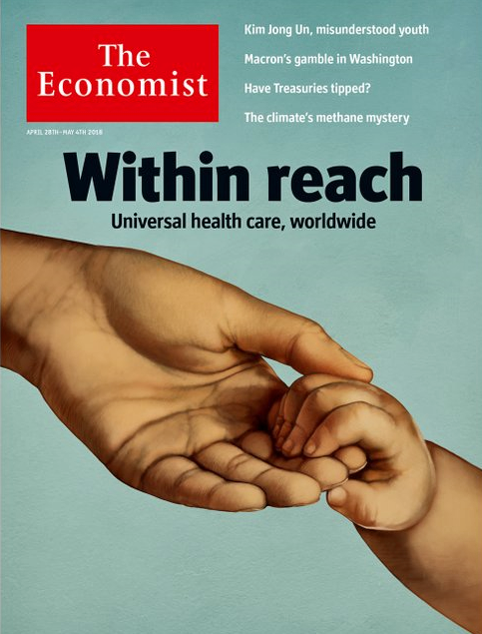
Two weeks in a row, The Economist, the news magazine headquartered in London, included two special reports stapled into the middle of the magazines. Universal health care was covered in a section on 28 April 2018, and coverage on financial inclusion was bundled into the 5th May edition. While The Economist’s editors may not have intended for these two reports to reinforce each other, my lens on health and healthcare immediately, and appreciatively, connected the dots between healthcare coverage and financial wellness. The Economist, not known for left-leaning political tendencies whatsoever, lays its bias down on the cover of the section here: universal healthcare
Food as Medicine – Philips’ Take On An Apple A Day from the Rijksmuseum

What if you went to visit a Vermeer still life with fruit, vegetables, and flowers, and the only image you saw in the famous painting was the flower and an urn? What if you heard the sounds of a juicing machine whirring as you reflected on a Rembrandt? That’s exactly what happened to museum-goers visiting Amsterdam’s Rijksmuseum. These art patrons witnessed a museum guard literally pulling an apple out of a painting, to leave a barren portrait of an urn and little else. Roll over, Anthony Oberman, the artist of “Still Life with Fruit in a Terracotta Dish,” one of
How We Spend Versus What We Get: America’s Healthcare Spending Makes for Poor Health
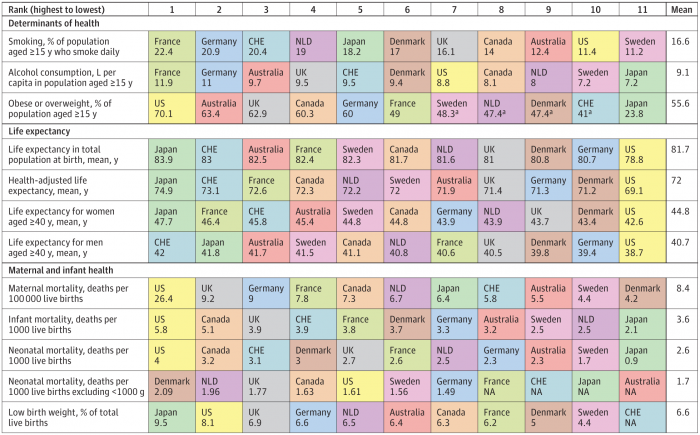
The U.S. spent nearly twice as much as other wealthy countries on healthcare, mostly due to higher prices for both labor and products (especially prescription drugs). And, America spends more on administrative costs compared to other high-income countries. What do U.S. taxpayers get in return for that spending? Lower life spans, higher maternal and infant mortality, and the highest level of obesity and overweight among our OECD peer nations. These sobering statistics were published in Health Care Spending in the United States and Other High-Income Countries this week in JAMA, the Journal of the American Medical Association. The study analyzes
Tweets at Lunch with Paul Krugman – Health IT Meets Economics
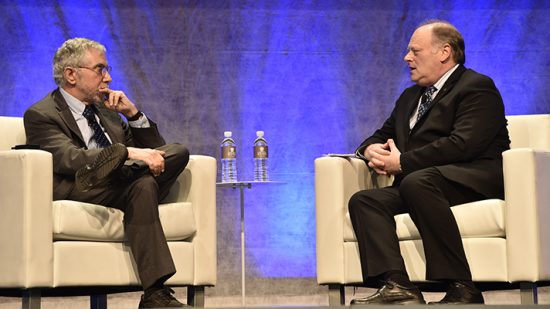
I greatly appreciated the opportunity today to attend a luncheon at the HX360 meeting which convened as part of the 2018 HIMSS Conference. The speaker at this event was Paul Krugman, who won the Nobel Prize for Economics 10 years ago and today is an iconic op-ed columnist at the New York Times And Distinguished Professor of Economics at the City University of New York (CUNY). I admit to being a bit of a groupie for Paul Krugman’s work. It tickles me to look at Rise Global’s list of the Top 100 Influential Economists:
The 2018 Edelman Trust Barometer – What It Means for Health/Care in America

Trust in the United States has declined to its lowest level since the Edelman Trust Barometer has conducted its annual survey among U.S. adults. Welcome to America in Crisis, as Edelman brands Brand USA in 2018. In the 2018 Edelman Trust Barometer, across the 28 nations polled, trust among the “informed public” in the U.S. “plunged,” as Edelman describes it, by 23 points to 45. The Trust Index in America is now #28 of 28 countries surveyed (that is, rock bottom), dropping below Russia and South Africa. “The public’s confidence in the traditional structures of American leadership is now fully
U.S. Healthcare Spending & Outcomes in Five Charts: #EpicFail in the 2017 OECD Statistics
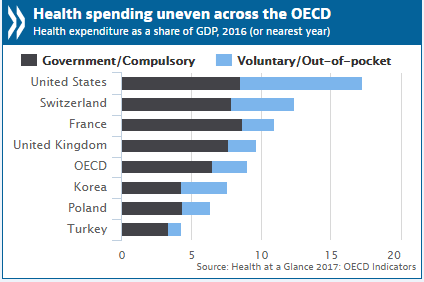
“Spend more. Get less.” If a retailer advertised using these four words, how many consumers would buy that product or service? This is the American reality of healthcare spending in 2016, told in the OECD report, Health at a Glance 2017. I present five charts from the study in this post, which together take the current snapshot health-economic lesson for the U.S. First, look at health expenditures as a share of gross domestic product: the U.S. is number one above Switzerland, France, and the UK, and about two times the OECD average. Note, too, the proportion of out-of-pocket and so-called
Income Inequality For Older Americans Among Highest in the World – What This Means for Healthcare
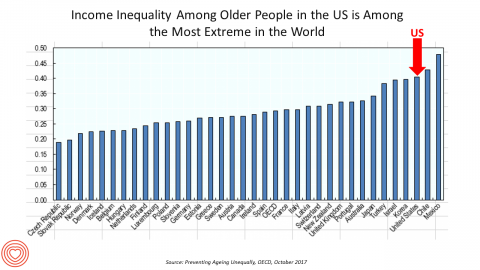
Old-age inequality among current retirees in the U.S. is already greater than in ever OECD country except Chile and Mexico, revealed in Preventing Ageing Unequally from the OECD. Key findings from the report are that: Inequalities in education, health, employment and income start building up from early ages At all ages, people in bad health work less and earn less. Over a career, bad health reduces lifetime earnings of low-educated men by 33%, while the loss is only 17% for highly-educated men Gender inequality in old age, however, is likely to remain substantial: annual pension payments to the over-65s today are
How We Live and Die in 2017: Obesity, Conflict and Mental Illness
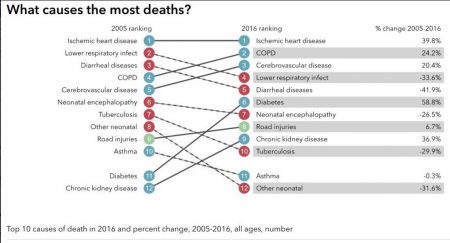
Obesity, conflict, and mental illness contribute most to the ill health and mortality of the world’s population – especially in the U.S., according to the annual Global Burden of Disease study published this month in The Lancet and funded by The Bill & Melinda Gates Foundation. There’s good news and bad news in this research: on the upside, people are living longer. On the downside, there’s a lot of morbidity – that is, sub-optimal health – in those years. The study examines both YLLs (years of life lost) and YLDs (years lived with disability). “Death is a powerful motivator, both
Fix the ACA, Most Americans Say
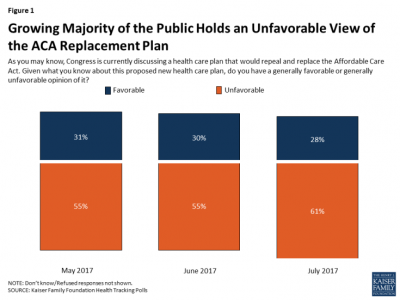
61% of Americans hold negative views of repealing-and-replacing the Affordable Care Act, according to the July 2017 Health Tracking Poll from the Kaiser Family Foundation. This month’s survey focused on Americans’ views on Republican legislative efforts to repeal and replace the Affordable Care Act (ACA). As of the writing of this post, the majority of the Senate rejected the full repeal of the ACA, but the situation is very fluid. Note that this poll was conducted by phone between July 5-10, 2017, among 1,183 U.S. adults ages 18 and older. The column chart here illustrates that the proportion of people
Is There Political Will for Healthcare Access in the US?
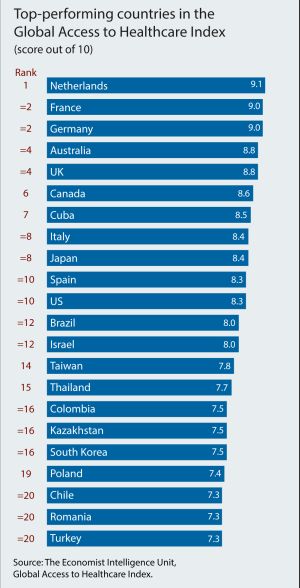
The Netherlands, France and Germany are the best places to be a patient, based on the Global Access to Healthcare Index, developed by the Economist Intelligence Unit (EIU). Throughout the world, nations wrestle with how to provide healthcare to health citizens, in the context of stretched government budgets and demand for innovative and accessible services. The Global Access to Healthcare Index gauges countries’ healthcare systems in light of peoples’ ability to access services, detailed in Global Access to Healthcare: Building Sustainable Health Systems. The United States comes up 10th in line (tied with Spain) in this analysis. Countries that score the
The Power of Joy in Health and Medicine – Learning From Dr. Regina Benjamin

Former Surgeon General Dr. Regina Benjamin was the first person who quoted to me, “Health isn’t in the doctor’s office. It’s where people live, work, play and pray,” imparting that transformational mantra to me in her 2011 interview with the Los Angeles Times. I wrote about that lightbulb moment here in Health Populi. Dr. Benjamin was the 18th Surgeon General, appointed by President Obama in 2009. As “America’s Doctor,” she served a four-year term, her mission focused on health disparities, prevention, rual health, and children’s health. Today, Dr. Benjamin wears many hats: she’s the Times Picayune/NOLA.com professor of medicine at
The Pharmacy as Herbalist – An Italian Prescription

CNN called it, “the ancient perfume store you never heard of,” but the Officina Profumo-Farmaceutica di Santa Maria Novella had its literal roots in medicinal herbs. With scents wafting onto a 13th century Florence piazza, the Farmacia now operates as a pharmacy storefront for homeopathic and herbal supplements, along with perfumes and home scents. A visit to the pharmacy today is a journey into medicinal time-travel, back to the year 1221. I spent time in the pharmacy today to learn about the literal roots of the shop in medicinal herbs cultivated in a monastery garden and reformulated by monks into
Slow Food As Medicine: Eating In Italian

States That Expanded Medicaid Improved Healthcare Access & Patient Outcomes

States that expanded Medicaid since the start of the Affordable Care Act made greater health system access improvements than those States that did not expand Medicaid, according to Aiming Higher: Results from the Commonwealth Fund Scorecard on State Health System Performance. There’s good news and bad news in this report: on the upside, nearly all states saw health improvements between 2013 and 2015, and in particular, for treatment quality and patient safety. Patient re-admissions to hospitals also fell in many states. But on the downside, premature deaths increased in nearly two-thirds of states, a reversal in the (improving) national mortality
Healthcare and the Autonomous Car: Setting the Stage for HIMSS17

The autonomous car is a metaphor for healthcare: that’s how my first interview kicking off the HIMSS marathon began. The annual 2017 HIMSS conference isn’t your father’s or mother’s HIMSS of ten years ago, or even the HIMSS of 2010 — the year that financial incentives for EHR adoption began to stream from the HITECH Act of 2009, motivating thousands of healthcare providers to acquire and meaningfully use digital health records systems. Then, the HIMSS conference floor was abuzz with EHR frenzy. This week, over 43,000 people working at the intersection of healthcare and technology have converged in Orlando, Florida, for
Americans Far More Likely to Self-Ration Prescription Drugs Due To Cost

Americans are more than five times more likely to skip medication doses or not fill prescriptions due to cost than peers in the United Kingdom or Switzerland. U.S. patients are twice as likely as Canadians to avoid medicines due to cost. And, compared with health citizens in France, U.S. consumers are ten-times more likely to be non-adherent to prescription medications due to cost. It’s very clear that more consumers tend to avoid filling and taking prescription drugs, due to cost barriers, when faced with higher direct charges for medicines. This evidence is presented in the research article, Cost-related non-adherence to prescribed
1 in 3 Americans Still Self-Rations Healthcare
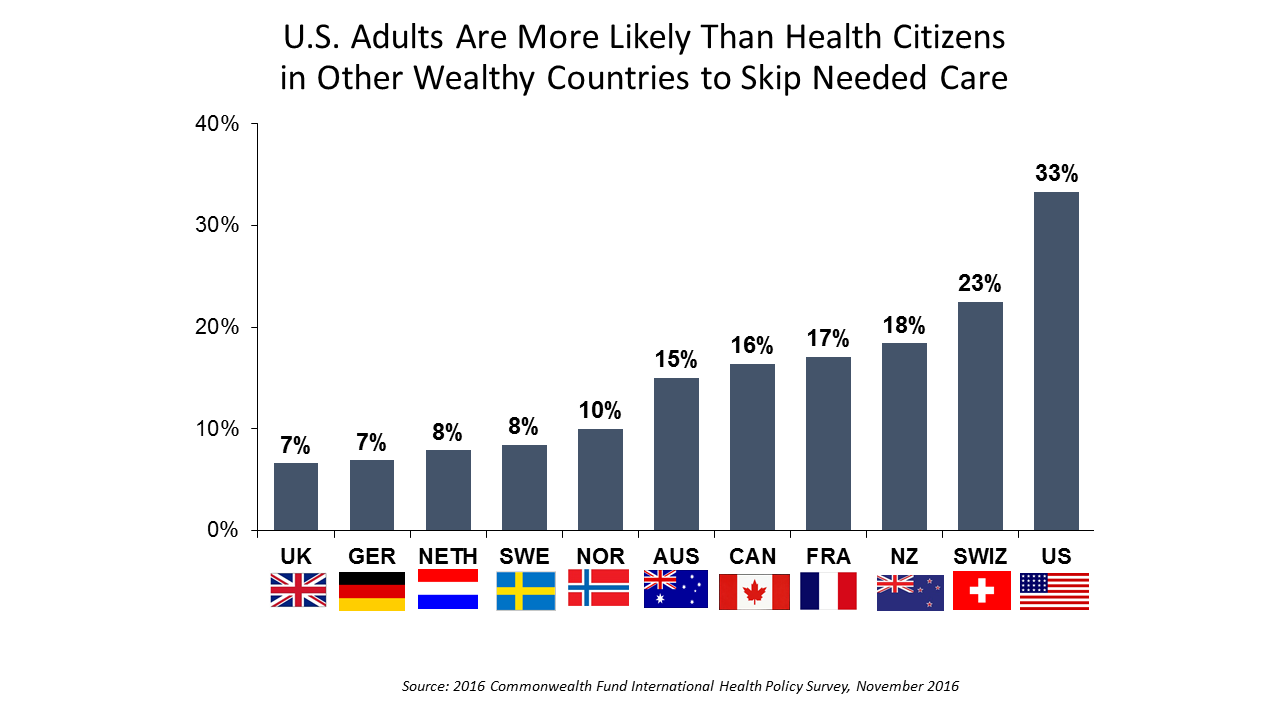
People in the U.S. are much more likely to go without health care they need compared with health citizens in 10 other wealthy countries, according to the Commonwealth Fund’s 2016 international survey. One-third of Americans did not seek care due to costs, including going without recommended care, failing to fill a prescription drug, and/or not seeing a doctor when sick. While this self-rationing proportion of Americans dropped from 37% in 2013, the U.S. still ranks #1 in foregoing necessary healthcare due to cost. “In comparison to adults in the other 10 countries, adult sin the U.S. are sicker and more
The Reshaping Medical Tourism Market: More US Patients Seek Lower-Priced Care Overseas

More U.S. patients are faced with spending more out-of-pocket for health care services, to meet high-deductible health plans and rationally spend their health savings account investments. As rational economic men and women, some are seeking care outside of the United States where many find transparently priced, high-value, lower-cost healthcare. Check out the table from the Medical Tourism Association, and you can empathize with cash-paying patients looking for, say, gastric bypass surgery or a heart valve replacement. My latest column in the Huffington Post discussed this trend, which points first to the Cleveland Clinic — a top-tier American healthcare brand that’s
It’s World Health Day: Stay Super, Act Local
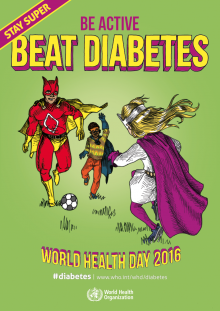
April 7 is World Health Day, and the World Health Organization (WHO) has named #diabetes the big public health challenge for 2016. What’s striking about this year’s World Health Day is the “Stay Super” public health ad campaign that WHO has developed featuring figures of super-people. THINK: Superman and Wonderwoman meet Doctors Welby, Kildare, and McDreamy. I’ve included several of the posters in the blog today to show how engaging health messaging works well when it works. The materials can be downloaded at this link. This week also saw the publication of America’s Health Rankings, spotlighting the impact of unhealthy behaviors.
Digital Health in the Skies Over Europe

“A full medical team via your mobile,” leads an article on clickdoctors.se, covering a Spanish mHealth start-up. This, in the February 2015 (Febrero 2015) issue of ling, the Vueling airlines magazine. I am flying from Florence, Italy, to London via Vueling airlines, heading from an art-and-Slow Food-filled holiday to a couple days of work in the UK. So imagine my surprise as I head to work on digital health and food projects in London reading this article enroute, in the lovely skies flying above the Alps. The story begins: “In 2050 Spain will be, along with Japan, one of the countries
What Zero Kilometers Means for Food and Health
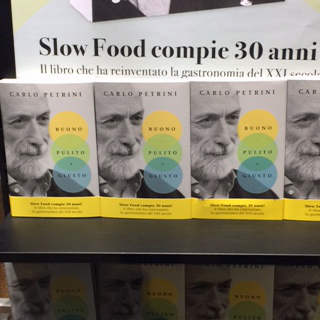
Italians get the food=health connection as a natural everyday behavior. So it’s no surprise that one of the fast-selling books in Italy’s librerias is about Slow Food – a movement that’s celebrating its 30th anniversary in that hot book by Carlo Petrini, a father of the Slow Food organization. I took the photograph this evening peering into a shop window during our post-dinner walk along the Via Gucciardini past the Giunti al Punto bookstore. [In full transparency, I’ve been a long-time member of this organization, represented by the little red snail icon.] The book has a three-word title: Buono, Pulito, Giusto. This
U.S. Health At A Glance – Not So Healthy
People in the U.S. have lower life expectancy, a growing alcohol drinking problem, and relatively high hospital inpatient rates for chronic conditions compared with other OECD countries. And, the U.S. spends more on health care as a percent of GDP than any other country in the world. This isn’t new-news, but it confirms that U.S. health citizens aren’t getting a decent ROI on health spending compared with health citizens around the developed world. In the OECD’s latest global look at member countries’ health care performance, Health at a Glance 2015, released today, the U.S. comes out not-so-healthy in the context
The rise and rise of noncommunicable diseases

Noncommunicable diseases (NCDs) are the #1 cause of death in the world. NCDs are the yin to the yang of infectious diseases. Mortality from infectious disease has fallen as national economies have developed, while NCDs such as heart disease, respiratory disease, cancer, diabetes, and other NCDs are a growing burden. Health Affairs devotes its September 2015 issue to The Growing Burden of Noncommunicable Diseases, featuring research focusing both on global trends and U.S.-specific challenges. In their look into the relationships between NCDs, unhealthy lifestyles and country wealth, Thomas Bollyky et. al. note that NCDs aren’t only the “diseases of affluence,”
Thinking about health disparities on Martin Luther King Day 2015
On this day celebrating Martin Luther King, Jr., I post a photo of him in my hometown of Detroit in 1963, giving a preliminary version of the “I Have a Dream” speech he would give two months later in Washington, DC. As I meditate on MLK, I think about health equity. By now, most rational Americans know the score on the nation’s collective health status compared to other developed countries: suffice it to say, We’re Still Not #1. But underneath that statistic is a further sad state of health affairs: that people of color in the U.S. have lower quality of
Who is perfect? Advocacy ads for real people.
What is the nature of disability? What is the nature of beauty? What is perfection? Who among us is perfect? These questions are at the heart (literally and figuratively) of a project undertaken by Pro Infirmis, a Switzerland-based advocacy organization raising awareness of people with disabilities, promoting the International Day of Persons with Disabilities in December 2013. Mannequins in fashionable shops on Zurich’s tony street the Bahnhofstrasse were replaced by new ones, artfully, painstakingly and lovingly created, as shown in the video. Pro Infirmis’s website tells us “who” we are looking at in human and 3-D life-size mannequin form: Miss Handicap 2010,
In pursuit of healthiness – Lancet talks US public health
It’s Independence Day week in America, and our British friends at The Lancet, the UK’s grand peer reviewed medical journal, dedicate this week’s issue to the Health of Americans – exploring life, death (mortality), health costs, chronic disease, and the Pursuit of Healthiness. This project is a joint venture between The Lancet and the U.S. Centers for Disease Control (CDC) which took 18 months to foster, called The Health of Americans Series. Americans mostly die from chronic diseases, aka non-communicable diseases, which are largely amenable to lifestyle changes like eating right, quitting smoking, drinking alcohol in moderation, and moving around more. 1 in
Zero kilometers and the future of food
I have seen the future of food and it is in Italy at a grocery chain called Conad, which launched a locavore-focused brand called Sapori & Dintorni. Here in Florence, Italy, where I’m spending a week’s holiday with my family, we stay in an apartment in the Oltrarno – just south of the Arno River, up a short hill from the southern tip of the Ponte Vecchio, the old bridge known for its gold and silver jewelry. But the real gem in this neighborhood is that grocery store, whose Sapori & Dintorni label represents food sourced from Italy’s great food
7 Women and 1 Man Talking About Life, Health and Sex – Health 2.0 keeping it real
Women and binge drinking…job and financial stress…sleeplessness…caregiving challenges…sex…these were the topics covered in Health 2.0 Conference’s session aptly called “The Unmentionables.” The panel on October 1, 2013, was a rich, sobering and authentic conversation among 7 women and 1 man who kept it very real on the main stage of this mega-meeting that convenes health technology developers, marketers, health providers, insurers, investors, patient advocates, and public sector representatives (who, sadly, had to depart for Washington, DC, much earlier than intended due to the government shutdown). The Unmentionables is the brainchild of Alexandra Drane and her brilliant team at the Eliza
Defining Mobile Health – the blur between health and health care
Mobilising Healthcare, a new report from Juniper Research, segments the mobile health sector into “healthcare” and “health & fitness” segments. The research summary notes that fitness is a relatively new market compared with health “care,” which has been around for eons. Fitness, the analysts say, “is exempt from government intervention.” Mobile healthcare (“mHealth”) applications explored include SMS health messaging, remote health provision such as cardiac monitoring, electronic health records and personal health records. In mFitness, Juniper looks into mobile tech for athletes and fitness conscious people, and activity tracking including heart function, distance, respiration, and perspiration, among other parameters. mHealth
Americans’ health not keeping up with the world: why to spend more on social determinants of health
The American health infrastructure is not First World or First Rate, based on the outcomes. This, despite spending more on health care per-person than any country on the planet. Two seminal reports are out this week reminding Americans that our return-on-investment in health spending is poor. The first research comes from JAMA titled The State of US Health, 1990-2010: Burden of Diseases, Injuries, and Risk Factors. There is some good news in this report at the top line: that life expectancy for Americans increased in the two decades from 75.2 years to 78.2 years. But this positive quantitative outcome comes with
Food = Health for employers, hospitals, health plans and consumers
Food is inextricably bound up with health whether we are well or not. Several key area of the Food=Health ecosystem made the news this week which, together, will impact public and personal health. On the employer health benefits front, more media are covering the story on CVS strongly incentivizing employees to drop body mass index (BMI) through behavioral economics-inspired health plan design of a $50 peer month penalty. Michelin, whose bulky advertising icon Bibendum has more than one “spare tire,” introduced a program to combat health issues, including but not limited to BMI and high blood pressure, according to the
U.S. Health Costs vs. The World: Is It Still The Prices, and Are We Still Stupid?
Comparing health care prices in the U.S. with those in other developed countries is an exercise in sticker shock. The cost of a hospital day in the U.S. was, on average, $4,287 in 2012. It was $853 in France, a nation often lauded for its excellent health system and patient outcomes but with a health system that’s financially strapped. A routine office visit to a doctor cost an average of $95 in the U.S. in 2012. The same visit was priced at $30 in Canada and $30 in France, as well. A hip replacement cost $40,364 on average in the
Bill Clinton’s public health, cost-bending message thrills health IT folks at HIMSS
In 2010, the folks who supported health care reform were massacred by the polls, Bill Clinton told a rapt audience of thousands at HIMSS13 yesterday. In 2012, the folks who were against health care reform were similarly rejected. President Clinton gave the keynote speech at the annual HIMSS conference on March 6, 2013, and by the spillover, standing-room-only crowd in the largest hall at the New Orleans Convention Center, Clinton was a rock star. Proof: with still nearly an hour to go before his 1 pm speech, the auditorium was already full with only a few seats left in the
Living paycheck to paycheck: what it means for health
While 50% of Americans feel they have a sound financial position, the other half is living paycheck to paycheck. 8% say they can’t even pay for essentials. The second annual Allstate “Life Tracks” Poll finds American adults split between have’s and have not’s, with even the “have’s” feeling less than financially literate. There is an equal split between people who feel they’re in an “excellent” or “good” financial position compared with those who feel they’re in financially “fair” or “poor” shape. Men feel more financially secure than women; 3 in 4 single parents feel less well-off compared to the average
Lower calories are good business
The restaurant chain business employs 10% of U.S. workers and accounts for $660 bn worth of the national economy. Where restaurant chains are growing fastest is in serving up lower-calorie meals, and it’s been a boon to the bottom-line. The case for lower calories leading to better business is made in Lower-Calorie Foods: It’s Just Good Business from the Hudson Institute‘s Obesity Solutions Initiative, published February 2013. In the report, researchers analyzed nitty-gritty restaurant chain data on servings and traffic from 2006-2011 to sort out whether sales of so-called lower-calorie menu items in 21 chains led to improved business. The chains
Dark chocolate as health food – a healthy salute to Valentine’s Day
On a recent Whole Living segment on Martha Stewart’s Sirius XM radio channel, I learned of the artisan chocolatier, Gnosis. The company, whose name is Greek for “knowledge,” grew out of the kitchen of a holistic health counselor, Vanessa Berg, who began to make nutritionally-infused sweets for her private clientele. Word-of-mouth made its way to a buyer from Whole Foods, who subsequently did a deal with Berg to sell Gnosis goods in some of the company’s stores in New Jersey and New York. Here’s a link to the radio interview. Chocolate is a health food for this company, and for
Americans are first in un-health: the US health disadvantage
In the U.S., we’ll be the #1 oil producer by 2020. We’re the largest national economy in the world (to be surpassed by China before 2030). And, we’re #1 in terms of the lowest taxes paid as a percentage of national GDP. That’s all heartening news for the time being. But we’re also #1 in what I’ll call “un-health:” in auto accident mortality for adolescents, obesity rates, infant mortality, prevalence of sexually transmitted diseases, and among other public health metrics. A report from the National Research Council and Institute of Medicine (NRC/IOM) calls out what JAMA terms The US Health Disadvantage:
Think about health disparities on Martin Luther King Day 2013
On this day celebrating Martin Luther King, Jr., I post a photo of him in Detroit in 1963, giving a preliminary version of his “I Have a Dream” speech he would give two months later in Washington, DC. As I meditate on MLK, I think about health equity. By now, most rational Americans know the score on the nation’s collective health status compared to other developed countries: suffice it to say, We’re Not #1. But underneath that statistic is a further sad state of health affairs: that people of color in the U.S. have lower quality of health than white
From fragmentation and sensors to health care in your pocket – Health 2.0, Day 1
The first day of the Health 2.0 Conference in San Francisco kicked off with a video illustrating the global reach of the Health 2.0 concept, from NY and Boston to Mumbai, Madrid, London, Tokyo and other points abroad. Technology is making the health world flatter and smarter…and sometimes, increasing problematic fragmentation, which is a theme that kept pinching me through the first day’s discussions and demonstrations. Joe Flowers, health futurist, offered a cogent, crisp forecast in the morning, noting that health care is changing, undergoing fundamental economic changes that change everything about it. These are driving us to what may
Personal health records and online record access – a view from the UK
Consumers’ online access to electronic health records is growing in and outside of the U.S. — particularly evident in the U.K., where the National Health Service (NHS) patients are being given online access to their health records held by primary care providers (GPs). This program is termed “Record Access” and could morph into the larger concept of personal health records which, today, aren’t prevalent in the U.K. A new report analyzes U.K. consumers’ perceptions about online health record access called, Personal Health Records: Putting Patients in Control? The report was published in the UK by 2020health.org with support from Microsoft. The report is written
Patients in emerging countries value mHealth, but sustaining mHealth behaviors is tough
Half of patients globally expect that mobile health will improve health care. These health citizens expect that mobile health will help them manage their overall health, chronic conditions, how they manage their medications and measure and share their vital health information. Welcome to the new mobile health world, a picture captured in PwC’s report, Emerging mHealth: Paths for growth, published in June 2012 and written by the Economist Intelligence Unit. Patients’ views on mHealth are bullish, and while most doctors and payors share that vision, they also expect mHealth to come into focus more slowly, recognizing the institutional, cultural and
A $132 doctor’s visit in Hanoi, Vietnam: a diagnosis, value-based health care and a new friend
$132 won’t go far in a U.S. emergency room, but in Vietnam, it gets you first class treatment, a highly-trained and empathetic French doctor, and cheap prescriptions, as well. You could call it Presidential treatment, as a certificate from the White House was proudly displayed in the lobby waiting area sent in appreciation of great care received by President George W. Bush. After arriving in Hanoi two nights ago, following three airline flights over nearly 24 hours, our daughter developed a rough cough that gave her chest pains. We gave the condition one day to improve and then spoke with
Patient engagement and medical homes – core drivers of a high-performing health system
It was Dr. Charles Safran who said, “Patients are the most under-utilized resource in the U.S. health system,” which he testified to Congress in 2004. Seven years later, patients are still under-utilized, not just in the U.S. but around the world. Yet, “when patients have an active role in their own health care, the quality of their care, and of their care experience improves,” assert researchers from The Commonwealth Fund in their analysis of 2011 global health consumer survey data published in the April/June 2010 issue of the Journal of Ambulatory Care Management. This analysis is summarized in International Perspectives on
Wellness and the global health citizen – carrying our own doctors, inside
Every patient carries her or his doctor inside, said the great Renaissance man, Albert Schweitzer. Based on Euro RSCG Worldwide’s Prosumer Report – My Body, Myself, Our Problem: Health and Wellness in Modern Times, health citizens globally have begun to take on Dr. Schweitzer’s vision. Clement Boisseau of Euro RSCG points out that people, globally, are fairly schizophrenic when it comes to thinking about empowerment over illness: check out the chart for perceptions by condition and disease state. Boisseau says that people perceive health today both in modern terms (such as feeling empowered to control some conditions), and archaic or “magically
The Trust Deficit – what does it mean for health care?
Technology, autos, food and consumer products — two-thirds of people around the globe trust these four industries the most. The least trusted sectors are media, banks and financial services. Welcome to the twelfth annual poll of the 2012 Edelman Trust Barometer, gauging global citizens’ perspectives on institutions and their trustworthiness. This survey marks the largest decline in trust in government in the 12 years the Barometer has polled peoples’ views. Interestingly, trust in government among US citizens stayed stable. The top-line finds a huge drop in global citizens’ trust in government, with a smaller decline for business. There’s an interplay
Value and values will drive the adoption of mobile health
This week’s mHealth Summit in Washington, DC, features scores of presentations, posters, and corporate announcements demonstrating the typical chaos of emerging technology markets: the Big Question at this stage on S-curves for new tech is always, “what’s the timing of the pace of change,” or for you mathematically-inclined readers, “what’s the slope of the mHealth adoption curve?” Before we address that question, let’s be transparent about the fact that there are several definitions of just what ‘mHealth’ is: purists may conceive it as covering only those health tools and applications that ‘go’ mobile–that is, that are deployed via mobile phones and
Health is a team sport: the 2011 Edelman Health Barometer
Lifestyle, nutrition, the environment and the health system are four key factors that people globally say have the most impact on their health. Underlying these influences, its friends and family who most shape our health, followed by government and business. Welcome to the 2011 Edelman Health Barometer, the third year the communications firm has polled health citizens around the world on their views on health, behavior change, and the use of information and digital tools. Edelman conducted 15,165 interviews 12 countries in North America, Asia and Europe to gather health citizens’ perspectives. The top-line, globally, is that there is a knowledge-action
A long-term care crisis is brewing around the world: who will provide and pay for LTC?
By 2050, the demand for long-term care (LTC) workers will more than double in the developed world, from Norway and New Zealand to Japan and the U.S. Aging populations with growing incidence of disabilities, looser family ties, and more women in the labor force are driving this reality. This is a multi-dimensional problem which requires looking beyond the issue of the simple aging demographic. Help Wanted? is an apt title for the report from The Organization of Economic Cooperation and Development (OECD), subtitled, “providing and paying for long-term care.” The report details the complex forces exacerbating the LTC carer shortage, focusing
Brand “Health:” where is it in the Top 100 most valuable brands?
Apple has supplanted Google as the world’s #1 most valuable brand, worth more brand-wise than Microsoft and Coca-Cola combined (#5 and #6). the other most valuable global brands are IBM, McDonalds, AT&T, Marlboro, China Mobile, and GE. Technology brands have significantly grown in value with consumers allocating more personal disposable income to products like tablet computers and smartphones, even in the face of recessionary economics the world over. Technology companies are now 1/3 of the top 100 brands. Millward Brown, the brand consultancy that is part of WPP, the global communications firm, has conducted the BrandZ top 100 most valuable
Are health innovation and cost-reduction mutually exclusive? Insights from West Wireless’s Health Care Innovation Day DC
Representatives from eight U.S. Federal government agencies, including the FDA and Veterans Administration, among others; health financiers (VCs, angels); health tech start-ups; providers, life science companies, and analysts, attended the Health Care Innovation Day DC sponsored by West Wireless Health Institute on April 28, 2011. The meeting had the tagline, A Discussion with the FDA, setting the stage for a day-long consideration of the role of regulation vis-a-vis health innovation. The $2.5+ trillion question (annual spending on health care in the U.S.) is: can innovation drive making health care “cheaper?” This was the underlying theme of the panel on which I sat
What telehealth can do for the Health of Nations
Health care cost increases are unsustainable the world over; in developed nations, the forecast is even more dire given exploding demand for health services as citizens age. Cisco polled senior leaders in health systems globally to gauge their views on the challenging state of health care in their respective nations, and prospects for health system improvement. The triple-mantra for senior health leaders is access, efficiency, and quality. Access takes the form in this survey in maldistribution and insufficient number of health professionals. Efficiency looks like patients referred for unnecessary care coupled with long lines (queues) for needed services. Quality measurement continues to
What the US health system can learn from mHealth expertise in emerging countries
There’s cameraphone hacking that morphs the phone into a blood test device. Embrace Labs in India builds an incubator for $25. Micro- mobile payments are financing health care on the ground in emerging economies. At SXSW in Austin, TX, on March 12, 2011, a globally experienced quartet of panelists shared their observations of working with highly constrained budgets in developing countries during the session, Mobile Health in Africa: What Can We Learn? The answer is: plenty. Doug Naegele of Infield Health moderated the panel, which included Patricia Mechael of the Center for Global Health and Economic Development at the Earth Institute, part of Columbia University; Josh
Closing pharma R&D plants: The New Rust Belts
Pfizer‘s closure of the R&D plant located in Sandwich, England, is a harbinger of more plant closings-to-come. With scenario planning hat cocked firmly on one’s head, what does this mean for the lovely region of Sandwich, and other towns where the pharmaceutical industry’s reduction in R&D spending is falling hard on similar plants located in developed Europe and the U.S.? I’m inspired by a story in today’s Financial Times, Supply Running Low, about the implications of the closure of the Pfizer R&D factory in Sandwich, England which, “pleases investors but calls into the question the flow of new blockbusters” according to
Innovation will turbocharge health globally and locally – the GE Global Innovation Barometer
While innovation, writ large, is an engine for economic growth, it’s especially going to positively impact many aspects of health and health care, based on GE’s Global Innovation Barometer 2011. To prep for this week’s meeting of thought leaders at the World Economic Forum in Davos, Switzerland, GE surveyed 1,000 senior business executives in 12 countries in December 2010 and January 2011. Execs were surveyed from 12 countries including Australia, Brazil, China, Germany, India, Israel, Japan, S. Korea, Saudi Arabia, UAE, Sweden and the U.S. While execs agree that virtually all aspects of citizens’ lives will be positively improved by innovation over
Health innovation in the U.S. is ours to lose
The U.S. has few bright spots when accounting for global trade: we import much more than we export. Entertainment is America’s #1 export. After that, medical innovation shines. But the window on that lead is closing. 92% of Americans believe it’s important for the U.S. to be the global leader in medical innovation and research. And, most Americans believe the U.S. has been in a strong position in medical innovation, research and development, and technical innovation, especially for new cures and treatments for patients, and medical innovations that create jobs and drive economic growth; but a weakening position in science,
Health citizens in emerging countries seek health information online even more than their peers in developed economies
1 in 2 people who use the internet to seek health information do so to self-diagnose; this is highest in China, US, UK, Russia, and Australia. Furthermore, health citizens in emerging economies including India, Russia, China, Brazil, and Mexico, may rely more on online health searches than people in developed countries. In these regions, health seekers face high costs of face-to-face visits with medical professionals. These global findings come out of the report, Online Health: Untangling the Web, from Bupa. Bupa is a health company based in the UK that serves 10 million members in 190 countries, and another 20 million
Kids in America have unequal health compared to most of the world’s rich nations
In a nation where ‘no child left behind’ has been a mantra, it’s clear that in the U.S., many children are left behind when it comes to health. UNICEF’s Report Card #9 is out from the Innocenti Research Centre, providing the league table for child well-being in the world’s 24 richest countries. In health inequality — that is, the gap between kids who have ‘average’ well-being in the U.S. and those who fall below — the U.S. ranks #22 among the 24 wealthiest nations in the world. While an educated guess might put U.S. kids’ health inequality below Switzerland, Norway, and Denmark,
Luxury goods: a hospital stay in the U.S., a Big Mac in Switzerland
‘Tis the season for luxury goods spending, if you’re lucky: under the tree, you might find a Swiss watch from Baume & Mercier or Piaget; , chocolates boxed from Lindt & Sprüngli; or a Bally-branded handbag. If you have to stay in a hospital in Switzerland, the average cost of one inpatient night would be $617. That same overnight stay in a U.S. hospital would be $3,612 — a luxury good by any standard. The U.S. inpatient stay average cost ranges from a low of $1,595 (about 2.5 times greater than the Swiss rate) and a high of $14,306 (at the 95th percentile). These costs come from
U.S. health citizens are less health-confident and satisfied than their peers overseas
Among all the world’s health citizens, there’s one nation over all that’s most likely to postpone health care due to cost: Americans. The Commonwealth Fund has surveyed the people of 11 nations to ascertain How Health Insurance Design Affects Access To Care And Costs By Income, In Eleven Countries. That’s the title of their analysis in Health Affairs, published online November 18, 2010. The U.S. spends far more per capita on health care than any of these nations, as well as much more as a percentage of gross domestic product (GDP) on health. However, as the chart shows, more money/spending doesn’t
There is nothing like a Dane – when it comes to health and IT
Virtually every primary care doctor in Denmark uses an electronic medical record. Danish health citizens can access their laboratory results, medication profiles, waiting list information, and other information through a digital signature: over 1 million of 5.5 million Danes have done so. This week, I had the honor of kicking off the online health track at the J. Boye 2010 conference in Aarhus, Denmark. I spent time with an HIT guru from a major Scandinavian university hospital; a member of the Danish public sector HIT organization; marketers from the pharmaceutical industry; an entrepreneur building a portal for the growing private health sector to bring transparency of quality,
Impeaching health reform: reflections on the night before 2010 mid-term election results
I find myself in London, England, on November 2, 2010, for a week of business in two European nations that extend universal health care to their citizens: the UK and Denmark. The Hill’s Healthwatch blog writes today that, “House Republicans will bring early vote on repeal of health reform.” Haley Barbour, head of the Republican Governors Association, exclaimed, “I think if [Republicans] don’t fully repeal and replace it, they will make such big changes in it over the next three years that you won’t recognize it.” Here in the UK, the Guardian newspaper published a column opining that, “At a macro level,
Finding value-for-money in health – a global epidemic
The $N zillion question – whether translated into Euros, yen, pounds, lira, or pesos – is how to get more quality care and access in national health systems, while curbing health spending. Health costs have increased faster than economic development in nearly all OECD countries in the past 15 years. For the acronym-challenged, the OECD is the Organization of Economic Cooperation and Development – comprised of, generally, the most economically developed nations on Earth. This week, health maestros from OECD nations are meeting to wrestle this intractable challenge. Health costs consume about 9% of OECD countries’ budgets. This proportion of national GDPs
ePatients: a connected, collaborative, creating community
The ePatient Connections (ePC) conference convened this week in the City of Brotherly Love, my town, Philadelphia. And indeed, the eHealth love did flow between health citizens and organizations that seek to serve them: technology developers and health providers, alike. My flying fingers recorded nearly fifty pages of notes, and these don’t even include two tracks’ worth of presentations — social networks in health and health games — because I was the emcee for mobile health track. However, this gave me the opportunity to get to know the 11 mHealth presenters and their organizations up-close-and-personal and to brainstorm with track attendees
Health and tax breaks in the U.S. – a global perspective
The U.S. has among the lowest tax-to-GDP ratios in the developed world, including state and local taxes. Only Mexico, Turkey and Korea have lower tax-to-GDP ratios among OECD members, at somewhere between 20 and 28%. The Organization for Economic Cooperation and Development (OECD) believes that U.S. tax rates are, in fact, too low and, even with modest tweaks upward, “would still keep the overall tax burden at a relatively moderate level and not impose excessive costs,” OECD states in its Economic Survey of the U.S., released today. “Tax breaks have grown significantly since the major tax reform of 1986,” the report notes, and
People use the cloud for photos and e-mail, not health information
People trust the Internet “cloud” to manage many parts of their personal information, especially photos, e-mail correspondence, contacts, and videos. But personal health and financial information? Not so much. The chart illustrates that only 1 in 5 global citizens use the cloud to manage personal health information. KPMG‘s report, Consumers & Convergence IV, highlights peoples’ feelings about privacy and security of their personal information, from vacation pictures to 401(k) statements. The verdict: most people trust of the cloud to store and share most kinds of their information except for their medical and financial information. Two-thirds of people globally use cloud computing applications,
Bienvenido, HolaDoctor!
Welcome, HolaDoctor, to the growing roster of consumer-facing health portals. La differencia, this time, is that HolaDoctor is an entirely Spanish-speaking website of comprehensive health information. The site focuses on health content and tools highly targeted to Hispanics and health issues of most concern. Known previously as DrTango, founded in 1999, HolaDoctor has at least 1.3 million Hispanic consumers who have registered on its site, and operates over 500 multilingual health websites under its corporate umbrella. The morphing from DrTango to HolaDoctor has to do with the organization’s launch of its consumer-focused health and wellness portal reaching out to Spanish speakers in the
Technology innovation, aging and public expectations drive up health spending around the world: OECD 2010
The 30 most developed countries, on average, allocated 9% of their national budgets to health care in 2008, up from 7.8% in 2000. The U.S., in contrast, spent 16% of GDP on health care, nearly one-half of which came from public treasury coffers. The graph illustrates the statistics for each OECD member nation and the share of health care paid by public and private sectors. Note that the light-blue bar segment for the U.S. is a far larger proportion of the total bar compared to other countries: that’s the private sector’s contribution to health spending versus the dark blue, government
More money, less effective: the U.S. ranks last again in health system effectiveness
Among seven developed countries – Australia, Canada, Germany, the Netherlands, New Zealand, the United Kingdom and the United States of America — it’s the U.S. that ranks dead last in the effectiveness of the nation’s health system. In particular, the U.S. rates poorly on the issues of coordination of health care, cost-related problems causing access challenges for health citizens, efficiency, equity, and long/healthy/productive lives for citizens. Of course, it also figures in that the U.S. spends more per capita on health care than any other country on the planet: $7,290 per person compared with Health Nation #1, the Netherlands, which
A healthier long life leads to greater health costs
There’s good news and bad news when it comes to living longer: the good news is, yes, you’ve lived a healthier life and thus, you’re living a longer life. The bad news is that your lifetime health costs are greater than those for a person who’s not had good health. While current health costs for healthy retirees are lower than those for the unhealthy, the lifetime health costs for healthy people are higher. This finding comes from a study asking the question, Does Staying Healthy Reduce Your Lifetime Health Care Costs?, from the Center for Retirement Research (CRR) at Boston College. Here
A Renaissance for U.S. health care: broadband as the canvas
I’m in a country this week where 66% of health providers have adopted 9 of 14 critical electronic health applications, according to a study from The Commonwealth Fund. According to the same study, only 26% of U.S. providers have opted into these functions. As I amble across cobblestoned and craggy streets, looking up to frescoe’d facades on 500 year old palazzi, church domes and the bluest sky ever, the signs of the Italian Renaissance are everywhere in walkable Florence, Italy. But it’s not all art and architecture, gelato and chianti for me this week. It’s also the techno-reality
The US vs. The World in Health Care – Failing at #1
We’re #1! is a cheer usually reserved for a point of pride: for a class valedictorian, perhaps, or a winning ball team. But in the game of health economics, being #1 isn’t something to be proud of when the investment doesn’t net out to a reasonable return. The 2009 OECD Health Data set is out, and this year’s top line message doesn’t differ much from last year’s: the US spends a whole lot more money on health care, and gets a whole lot less in terms of life expectancy, infant morbidity, and epidemic obesity rates which inevitably lead to
Vaccines update – more news, less confusion, and part of economic stimulus
In 2008, mass media coverage of vaccines seemed more focused on pop celebrity fights, pro- and con-, versus scientific revelations. Will 2009 yield more knowledge and less confusion? 2008 was something of an Amanda Peet-versus-Jenny McCarthy show, pro v. con, taking place on the covers of People magazine and in YouTube videos. But just in the past few weeks, there’s been a subtle shift in news about vaccines toward more solid information. The headline points are: Minnesota children came down with the Hib virus, with blame going first to the Hib vaccine shortage and possibly, too, to 3 in 5
From Asheville NC to England — bribing people to seek health care
The National Health Service wants to launch a program in the UK that would provide cash payments to citizens to incentivize them to see their primary care doctors to deal with health problems such as diabetes, heart disease and obesity. National Health Service managers are looking to get higher-risk patients into the system sooner for prevention. As in the US, the UK suffers from health disparities between urban and rural populations, and between people from different socioeconomic classes. The idea is being promoted by the North-East Essex primary care trust. This area covers about 315,000 citizens of Colchester and Tendring.
In the health system popularity contest, the U.S. loses
In this season’s Health System Idol contest, the U.S. loses to most other developed countries. One in three Americans would like to “completely rebuild” the U.S. health system, according to The Harris Poll conducted in ten nations. And another 50% believe that, “fundamental changes are needed to make it work better.” Harris also measured ‘unpopularity’ with another metric: asking whether, “the system works pretty well and only minor changes are necessary.” Adding this yin to the other yang, the mash-up is still the same: the U.S. plays last fiddle to the rest of the world’s health system orchestra.
A View from the UK: Is Preventive Care "Worth It?"
I’m enjoying a weekend with London-based friends who travel the world and know what’s what. Today, we spent hours relishing (literally) the Borough Market in Southwark, located south of the Thames. This is London’s oldest food market, established when the Romans built the first London Bridge. The Market in its current state has been around for a quarter of a millenium. The Market boasts and hosts a glorious array of green grocers, bread bakers, Spanish food purveyors, brownie makers, organic tofu purveyors, and parmigiano reggiano vendors in one spot I’ve seen, perhaps ever. It is foodie heaven and a
Steel, Coffee Beans and Health Care
The UAW and GM have been debating health care as Friday’s deadline for their national contract approaches. This round of negotiation is about survival. Yesterday, I covered the rising costs of employer-sponsored health insurance. Today, let’s visit the intimately-related topic of retiree health benefits. These are eroding even faster than health benefits for employed workers. Many employers have significantly scaled back health benefits for retirees. Currently, one in three large employers offers retire benefits, compared with two in three in the late 1980s. Consider the predicament of the company ranked #3 on the 2006 Fortune 500 list, General Motors. Retirees





 I'm in amazing company here with other #digitalhealth innovators, thinkers and doers. Thank you to Cristian Cortez Fernandez and Zallud for this recognition; I'm grateful.
I'm in amazing company here with other #digitalhealth innovators, thinkers and doers. Thank you to Cristian Cortez Fernandez and Zallud for this recognition; I'm grateful. Jane was named as a member of the AHIP 2024 Advisory Board, joining some valued colleagues to prepare for the challenges and opportunities facing health plans, systems, and other industry stakeholders.
Jane was named as a member of the AHIP 2024 Advisory Board, joining some valued colleagues to prepare for the challenges and opportunities facing health plans, systems, and other industry stakeholders.  Join Jane at AHIP's annual meeting in Las Vegas: I'll be speaking, moderating a panel, and providing thought leadership on health consumers and bolstering equity, empowerment, and self-care.
Join Jane at AHIP's annual meeting in Las Vegas: I'll be speaking, moderating a panel, and providing thought leadership on health consumers and bolstering equity, empowerment, and self-care.